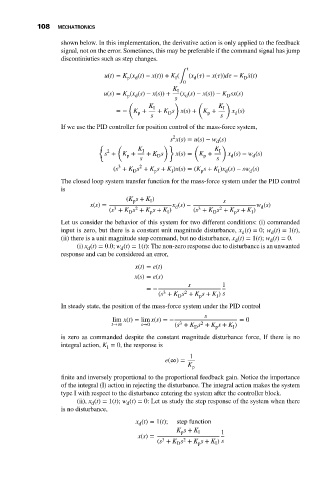Page 122 - Mechatronics with Experiments
P. 122
108 MECHATRONICS
shown below. In this implementation, the derivative action is only applied to the feedback
signal, not on the error. Sometimes, this may be preferable if the command signal has jump
discontiniuties such as step changes.
t
u(t) = K (x (t) − x(t)) + K ( (x ( ) − x( ))d − K ̇ x(t)
p d I ∫ 0 d D
K I
u(s) = K (x (s) − x(s)) + (x (s) − x(s)) − K sx(s)
p d d D
s
( ) ( )
K I K I
=− K + + K s x(s) + K + x (s)
p D p d
s s
If we use the PID controller for position control of the mass-force system,
2
s x(s) = u(s) − w (s)
d
{ ( )} ( )
K I K I
2
s + K + + K s x(s) = K + x (s) − w (s)
p D p d d
s s
3
2
(s + K s + K s + K )x(s) = (K s + K )x (s) − sw (s)
D p I p I d d
The closed loop system transfer function for the mass-force system under the PID control
is
(K s + K ) s
p
I
x(s) = x (s) − w (s)
d
d
2
3
3
2
(s + K s + K s + K ) (s + K s + K s + K )
I
p
D
p
I
D
Let us consider the behavior of this system for two different conditions: (i) commanded
input is zero, but there is a constant unit magnitude disturbance, x (t) = 0; w (t) = 1(t),
d d
(ii) there is a unit magnitude step command, but no disturbance, x (t) = 1(t); w (t) = 0.
d d
(i) x (t) = 0.0; w (t) = 1(t): The non-zero response due to disturbance is an unwanted
d d
response and can be considered an error,
x(t) = e(t)
x(s) = e(s)
s 1
=−
3
2
(s + K s + K s + K ) s
p
D
I
In steady state, the position of the mass-force system under the PID control
s
lim x(t) = lim x(s) =− = 0
3
2
t→∞ s→0 (s + K s + K s + K )
D
I
p
is zero as commanded despite the constant magnitude disturbance force, If there is no
integral action, K = 0, the response is
I
1
e(∞) =
K
p
finite and inversely proportional to the proportional feedback gain. Notice the importance
of the integral (I) action in rejecting the disturbance. The integral action makes the system
type I with respect to the disturbance entering the system after the controller block.
(ii), x (t) = 1(t); w (t) = 0: Let us study the step response of the system when there
d
d
is no disturbance,
x (t) = 1(t); step function
d
K s + K I 1
p
x(s) =
3
2
(s + K s + K s + K ) s
p
I
D

